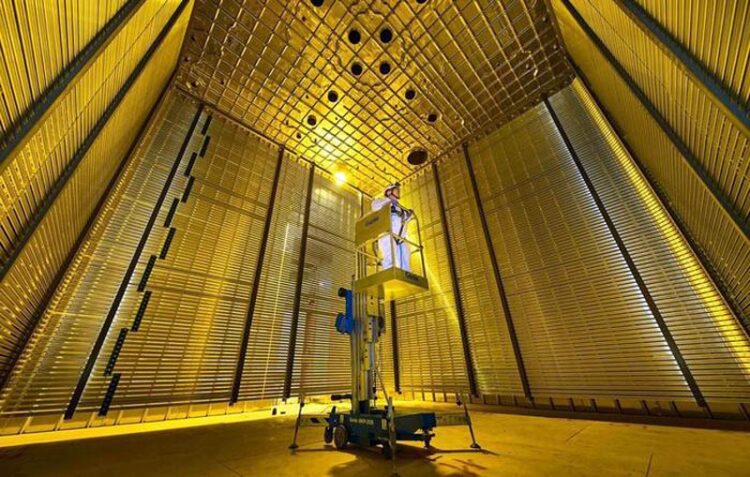UTA preps giant particle detectors for neutrino project

Jaehoon Yu, UTA professor of physics, stands on an elevated platform inside the DUNE field cage prototype after its completion at CERN in 2018.
Photo credit UT Arlington
Excavation of caverns part of Fermilab’s Deep Underground Neutrino Experiment.
With excavation work complete at the site where four gigantic particle detectors for the international Deep Underground Neutrino Experiment (DUNE) will be installed, scientists are preparing to begin construction on first detector. Part of that work is taking place at The University of Texas at Arlington.
Located a mile below the surface at the Sanford Underground Research Laboratory in Lead, South Dakota, the three colossal caverns serve as the core of a new research facility that spans an underground area about the size of eight soccer fields.
Hosted by the U.S. Department of Energy’s Fermi National Accelerator Laboratory (Fermilab), DUNE scientists will study the behavior of mysterious particles known as neutrinos to solve some of the biggest questions about the universe. These include why the universe is composed of matter, how an exploding star creates a black hole and if neutrinos are connected to dark matter or other undiscovered particles.
Jaehoon Yu, professor of physics, and Jonathan Asaadi, associate professor of physics, are leading UTA’s involvement with the project.
“The actual excavation took only a year, which is amazing,” Yu said. “It’s great that the excavation work is finished and now preparations can be made for the installation of the detectors. This is an exciting time.”
The caverns provide space for four large neutrino detectors—each one about the size of a seven-story building. The detectors will be filled with liquid argon and record the rare interaction of neutrinos with the transparent liquid.
With DUNE, scientists will look for neutrinos from exploding stars and examine the behavior of a beam of neutrinos produced at Fermilab, located near Chicago, about 800 miles east of the underground caverns. The beam, produced by the world’s most intense neutrino source, will travel straight through earth and rock from Fermilab to the DUNE detectors in South Dakota. No tunnel is necessary for its path.
UTA’s Department of Physics has been involved with the DUNE project since its earliest stages. In January 2016, UTA hosted a four-day international planning conference, organized by Yu.
UTA physicists will now build portions of the first two detectors to be installed at the South Dakota site. Specifically, they will construct modules of the field cage—100 modules for the first detector and all 200 of the modules for the second detector. The work will take place in the Chemistry and Physics Building.
“We’re going to need to recruit a lot of students to help with this work,” Yu said. “We need to bring them in as freshmen and sophomores so we can train them, and they can be with the project as long as possible, including for the installation.”
Yu will lead UTA’s efforts for construction of parts for the “far” detector in South Dakota. Asaadi is working on portions of the “near” detector at Fermilab.
The DUNE collaboration includes more than 1,400 scientists and engineers from over 200 institutions in 36 countries.
Media Contact
Katherine Bennett
University of Texas at Arlington
katherine.bennett@uta.edu
All latest news from the category: Physics and Astronomy
This area deals with the fundamental laws and building blocks of nature and how they interact, the properties and the behavior of matter, and research into space and time and their structures.
innovations-report provides in-depth reports and articles on subjects such as astrophysics, laser technologies, nuclear, quantum, particle and solid-state physics, nanotechnologies, planetary research and findings (Mars, Venus) and developments related to the Hubble Telescope.
Newest articles

Innovative 3D printed scaffolds offer new hope for bone healing
Researchers at the Institute for Bioengineering of Catalonia have developed novel 3D printed PLA-CaP scaffolds that promote blood vessel formation, ensuring better healing and regeneration of bone tissue. Bone is…

The surprising role of gut infection in Alzheimer’s disease
ASU- and Banner Alzheimer’s Institute-led study implicates link between a common virus and the disease, which travels from the gut to the brain and may be a target for antiviral…

Molecular gardening: New enzymes discovered for protein modification pruning
How deubiquitinases USP53 and USP54 cleave long polyubiquitin chains and how the former is linked to liver disease in children. Deubiquitinases (DUBs) are enzymes used by cells to trim protein…


